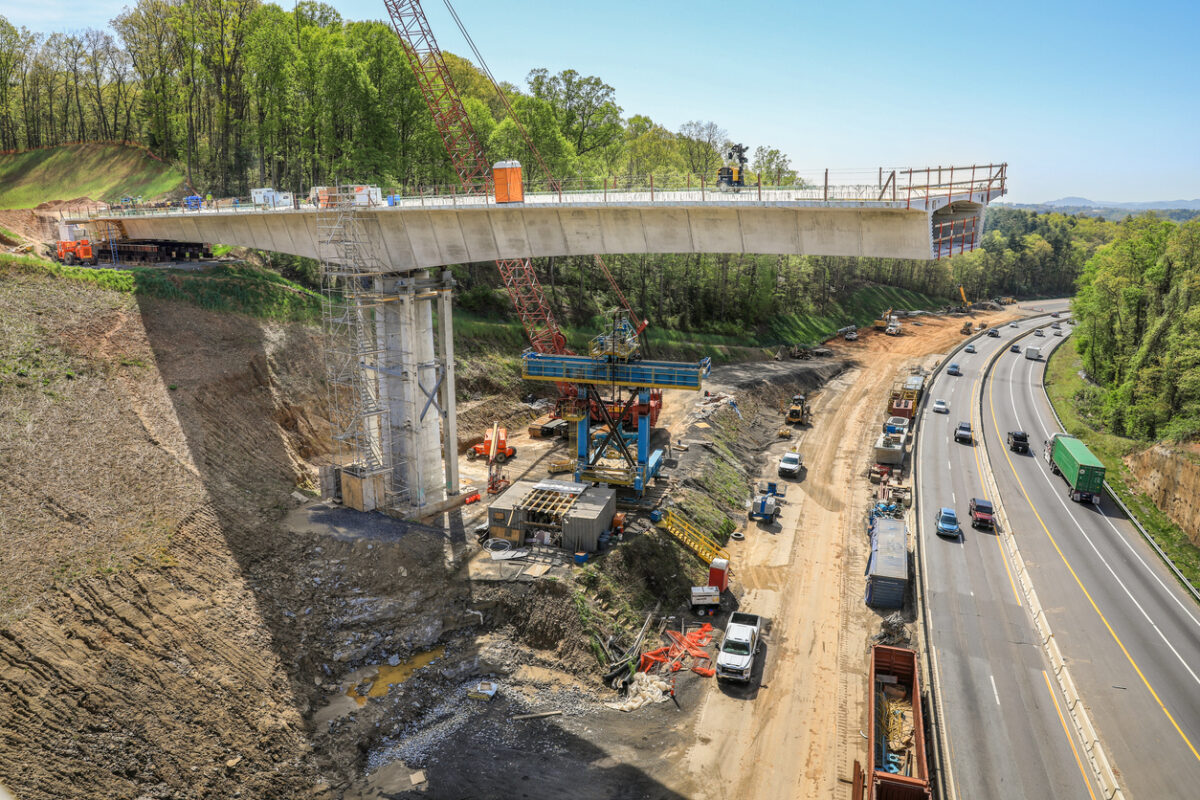
EJCDC’s new Construction Manager At-Risk documents enable owners and contractors to take advantage of the benefits of the CM At-Risk project delivery method.
Construction delivery systems have been evolving for decades as owners and contractors continue to search for ways to increase efficiency and reduce costs on their projects. One strategy that has been gaining in popularity with both public and private owners in recent years is Construction Manager At-Risk (CMAR). Under this system, the owner retains a contractor to provide both preconstruction and construction services at a guaranteed maximum price.
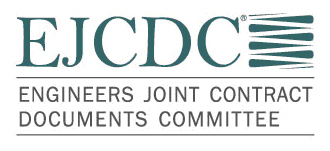
Many owners and contractors have modified traditional design-bid-build and/or design-build contracts for CMAR projects. But this approach has not enabled them to enjoy all of the advantages that CMAR can provide. So the Engineers Joint Contract Documents Committee (EJCDC), which includes representatives from The American Council of Engineering Companies, the National Society of Professional Engineers, and the American Society of Civil Engineers–Construction Institute, developed and recently released a set of CMAR-specific, comprehensive and coordinated contract documents. The set includes models for contracts, bonds, contractor procurement, and administrative forms.
Managing Risks and Improving Outcomes

Coy Veach, who chaired the EJCDC CM Committee, said that owners’ and contractors’ experiences during the pandemic and its aftermath increased their interest in and use of CMAR, resulting in a greater need for CMAR-specific documents.
“Since COVID-19, the nature of construction has changed significantly. Owners have growing concerns about what their projects will cost and about how long it will take to complete them with the current state of the construction industry. We are seeing projects that exceed budgeted funds and take longer to build, primarily because of escalation in material prices, supply chain issues, and a shortage of skilled labor,” said Veach, who is a Vice President of Freese and Nichols Inc., an engineering consulting firm. In this environment, contractors are often more reluctant to take on the same amount of project risk that they had assumed in the past.
As a result, fewer contractors are bidding on work; and owners can end up paying premium prices for their projects or even cancelling them. To increase competition and keep prices down, owners have had to find ways to make their projects more attractive to these contracting companies. Through the CMAR project delivery system, owners and contractors can address many of the issues that have increased prices and lengthened project schedules.

For public owners in particular, CMAR presents an acceptable bridge between the traditional design-bid-build approach, in which the owner controls the design, and a design-build approach, in which the designer works with the contractor to develop the design. “CMAR offers some of the advantages of design-build, such as progressive fast-track construction and getting pre-construction services from a contractor; but, at the same time, it allows the owner to continue to work hand-in-glove with the design professional,” said Hugh Anderson, Esq., the legal advisor for the CMAR Documents Committee.
Collaboration Improves Outcomes
The biggest benefit of the CMAR project delivery system is that it provides a way for owners, designers, and contractors to take a more collaborative approach to risk management. “They can sit down together at the pre-construction phase and gain an understanding of what the risks are and then figure out how to mitigate them,” Veach said. “The ability to collaborate in identifying risk elements in the preconstruction phase and to develop workable management strategies provides a significant step up in risk management based on the specific risk factors facing each party.”
EJCDC designed the CMAR documents with a structure that facilitates these kinds of collaborations among the owner, designer, and builder. Using these documents as models, the parties can plan how to construct the project to counter cost escalation and supply chain issues. The construction manager at risk, for example, can provide and maintain cost projections and scheduling, make recommendations that can impact cost and time of construction, improve quality by providing constructability reviews, and plan for procurement of equipment and materials. Using early work authorizations, which can be detailed using the CMAR-545 document, the contractor can purchase critical equipment and materials as soon as specifications are ready. This fast-track approach saves time and enables the contractor to better manage cash flow related to retainage and amounts for work bonded.
“If contractors are brought in the project early, to supplement the good work being done by the design professionals, it can enhance the quality of the project,” said Anderson.
While owners recognize the value that preconstruction services can bring to a project, they may not realize that value unless there is a clear understanding between the owner and the CMAR about what those services should include. To avoid this scenario, owners and CMARs can establish the scope of work using the EJCDC document CMAR-525, Owner-CMAR Agreement.
CMAR documents can also be helpful for owners that have had less than favorable results with low-bid contractors. Owners want their preconstruction services provided by construction contractors that have hands-on, in-the-field experience with scheduling, cost estimating, and constructability concerns. The EJCDC’s CMAR-210 form, Statement of Qualifications – Construction Manager At-Risk provides owners with a more structured way of selecting a CMAR. By requiring all bidders to use this form, owners have a better way of comparing bidders’ skills and experience.
Owners may also find it valuable to procure the services of an owner’s advisor that is experienced in the CMAR project delivery system and its more complex financial management requirements. So the CMAR documents include model agreements for an owner’s advisor as well as agreements between an owner and an engineer.
“Having documents that coordinate the owner’s agreements with its engineer, owner’s advisor and construction manager helps avoid gaps and overlaps in the services of these entities,” Veach said.
The use of EJCDC document CMAR-523 enables a CMAR and its subcontractors to clearly delineate their responsibilities and their expectations. That’s especially important in today’s environment, where general contractors are less likely to cover their subcontractors’ completion of their work. Through this agreement, the CMAR and its subs can prevent misunderstandings and disputes during construction, defining up front the work that is to be performed and identifying any safety, indemnity, and insurance provisions that apply to the specific job.
“We felt that it was important to get some of those provisions in the prime agreement to flow down to the subcontractors, but also at the same time not to hamstring good contractors and the working relationships they already have with their subs,” Veach said.
Designed for Modification
The 28 coordinated documents in EJCDC’s CMAR series can be used by the project partners at every point in the undertaking, starting with the selection of the CMAR by the owner through the project closeout and correction periods.
The documents are intended as model agreements, but the EJCDC recognizes that laws and regulations regarding CMAR vary, sometimes significantly, from state to state. So the committee expects that the documents, which are provided electronically in Microsoft Word and Excel, will require modifications to meet the legal requirements of different states, owner preferences, funding agency requirements, and project-specific needs.
To assist project partners, each of the CMAR documents includes extensive guidance notes to provide information and instruction on the choices that they can make. The set also includes specific notes to users, inserted immediately ahead of the places in the documents that need to be edited for each owner or project.
Although individual sections (documents) can be purchased individually, Veach said EJCDC recommends purchasing the entire set because each document is coordinated with other documents in the CMAR sections. While it is possible to use just one or two documents with other forms or documents, the wording in all documents used for a particular project (like definitions, for example) must be reviewed to ensure that they are aligned. That step can be eliminated if the documents all come from the CMAR set.
For more information about the CMAR document set and to find out how to purchase it, visit the EJCDC website. A summary of all the CMAR documents is included on the Surety Bond Quarterly website at https://www.suretybondquarterly.org/.
Bond-Related Documents in EJCDC CMAR Package
The EJCDC CMAR documents include standard bond forms for proposal security, performance, payment, and warranty (maintenance). NASBP CEO Mark McCallum worked with EJCDC’s legal counsel Hugh Anderson to review and update these bond forms. EJCDC also sought feedback on the documents from the Surety & Fidelity Association of America.
The specific CMAR documents that relate to bonding include:
CMAR-051 – A suggested letter from the owner’s advisor to the owner requesting instruction about bonds and insurance.
CMAR-052 – A document that provides model language that the owner can use in responding to that letter.
CMAR 430 – A form that a qualified surety can use to issue a bond that a contractor (proposer) will submit with its proposal to the owner. The document provides assurance that the contractor will enter into the CMAR contract with the owner if the owner awards the contractor the project. If the contractor doesn’t accept the award and doesn’t enter into the contract or provide the required performance and payment bonds, the proposal bond specifies the penalty that the contractor (or its surety) will have to pay.
The Performance Bond (C-610), the Warranty Bond (C-612) and the Payment Bond (C-615) documents are all taken directly from EJCDC’s Construction Series Documents.
“We did not see the need to create a CMAR document that would be identical to one that already exists,” said Coy Veach, who chaired the EJCDC CMAR committee.
2023 EJCDC Construction Manager At-Risk Series Documents
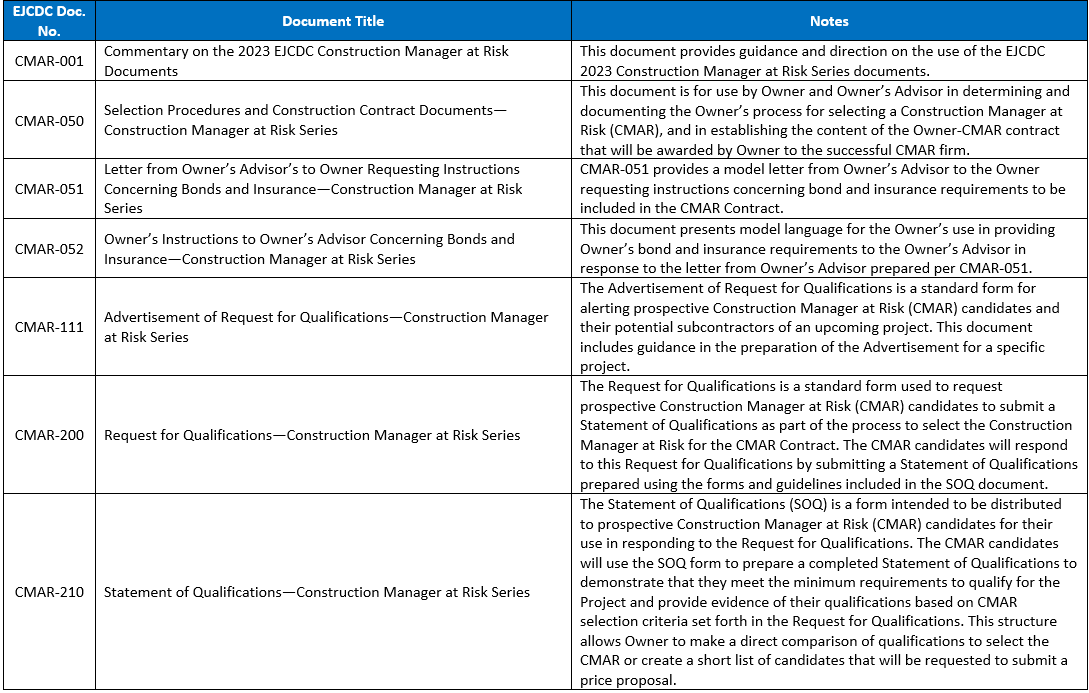
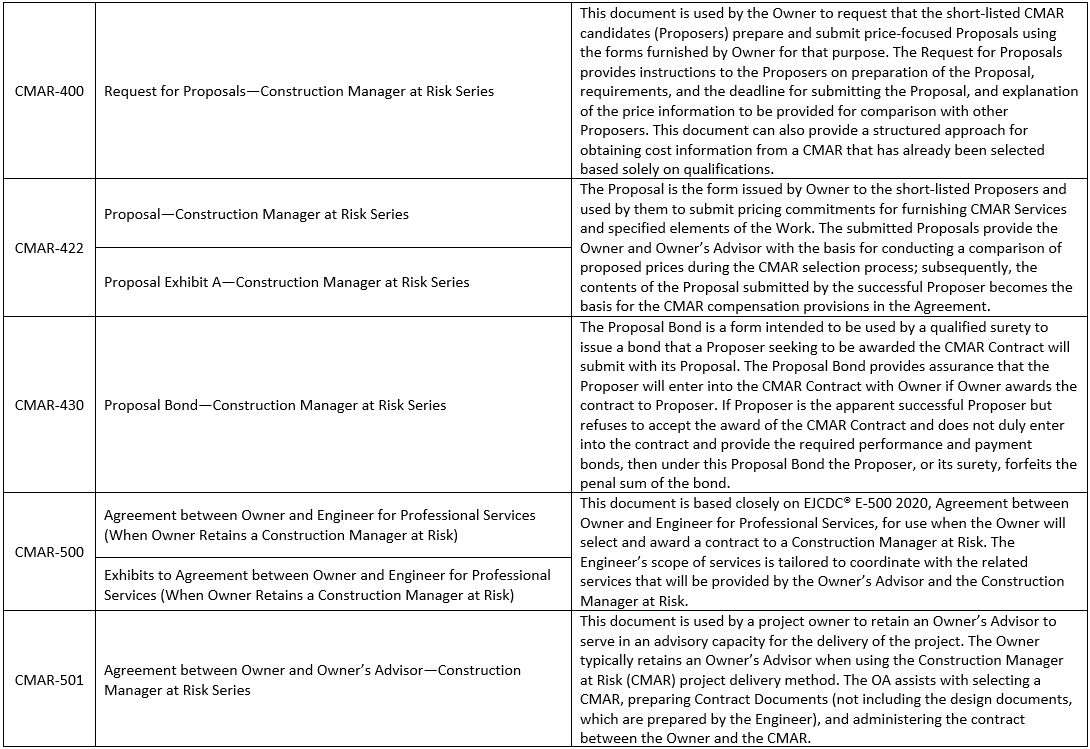
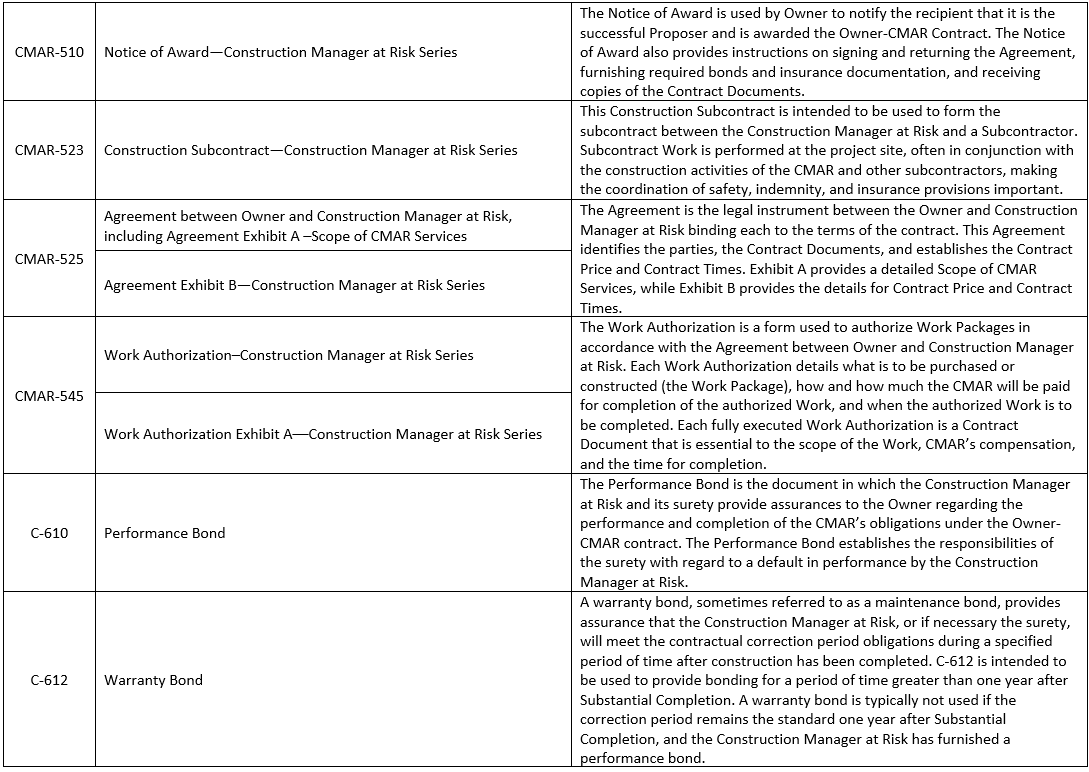
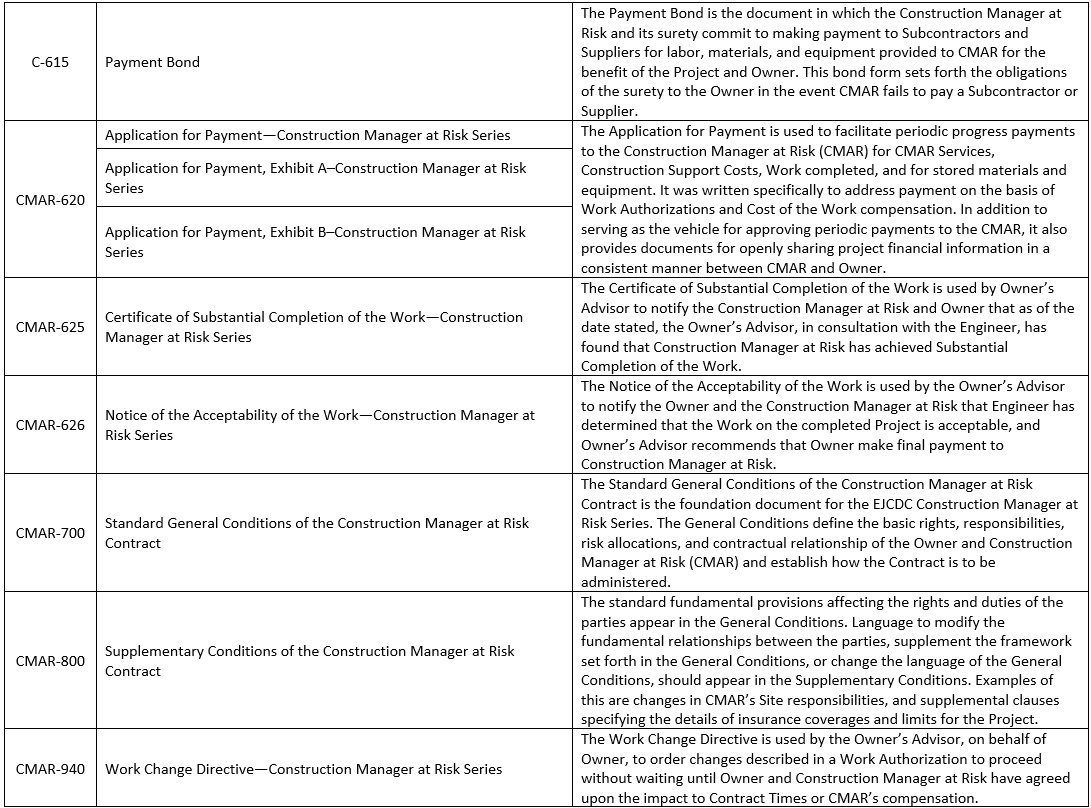

 Surety Bond Quarterly Professionals in Surety Bonding
Surety Bond Quarterly Professionals in Surety Bonding
